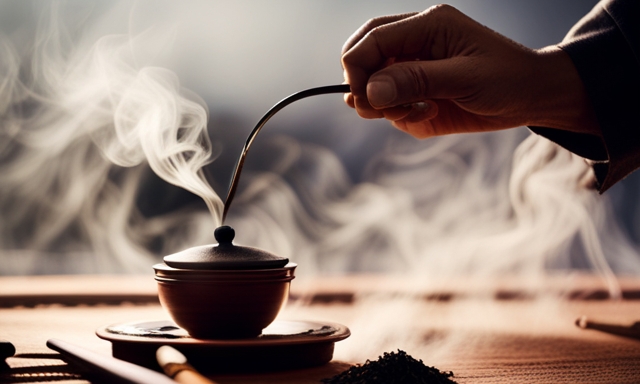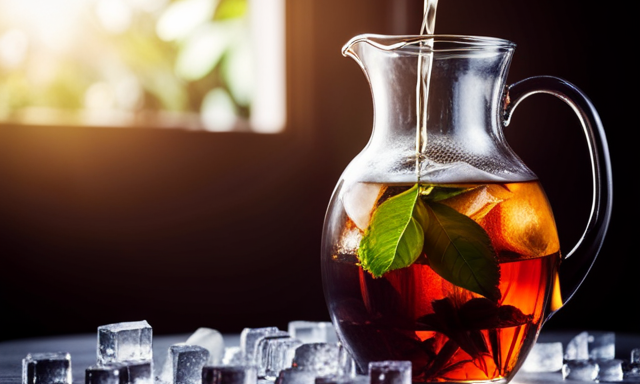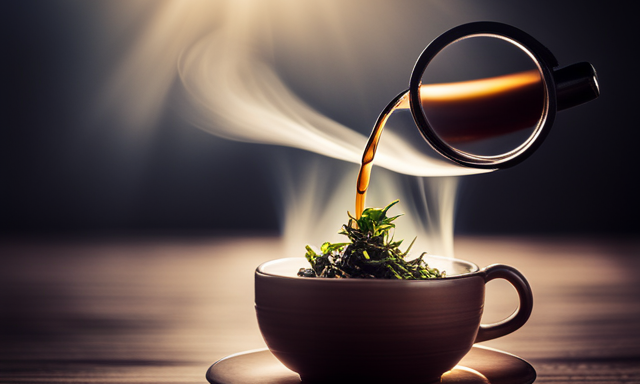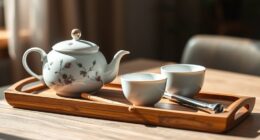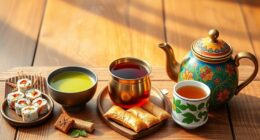In this article, I will delve into the fascinating world of oolong tea, exploring its origins, unique processing methods, and the spectrum of flavors it offers.
We will also discuss the health benefits of oolong tea, its caffeine content, and its deep-rooted cultural significance.
From popular varieties to perfect food pairings, we will leave no leaf unturned.
Oolong tea is not just any type of tea; it is a captivating and dynamic beverage that has been enjoyed for centuries.
So, grab your favorite teacup and join me on this journey to discover what makes oolong tea so special.
Key Takeaways
- Oolong tea falls between green tea and black tea in terms of oxidation levels.
- Oolong tea has a unique processing method that involves withering, partial oxidation, and heating.
- Oolong tea offers a wide range of flavors, including floral and fruity undertones, as well as roasty and nutty undertones.
- Oolong tea provides numerous health benefits, such as boosting metabolism, improving digestion, and promoting heart health.
Origins of Oolong Tea
Oolong tea has its origins in China and Taiwan. It falls between green tea and black tea in terms of oxidation levels. Oolong tea is made from the leaves of the Camellia sinensis plant. However, what sets oolong tea apart is its unique processing methods.
The production of oolong tea involves a partial oxidation process. The leaves are withered, rolled, and then oxidized to a specific level. This level of oxidation can vary depending on the desired taste and aroma of the tea. The result is a tea that has a delicate and complex flavor profile.
Now, let’s delve into the unique processing methods that give oolong tea its distinctive characteristics.
The Unique Processing Methods
Characterized by intricate processing methods that border on sorcery, oolong undergoes a transformation that is nothing short of miraculous. The unique brewing methods of oolong tea contribute to its distinct flavor profile and make it a staple in Chinese tea ceremonies.
-
The leaves of oolong tea are carefully picked, withered, and partially oxidized before they are heated to stop the oxidation process. This delicate balance of oxidation creates a tea that falls between green and black tea in terms of flavor and aroma.
-
Oolong tea leaves are often rolled or twisted into tight balls, which allows the leaves to unfurl during brewing and release their full flavor.
-
Some oolong teas are even roasted after processing, giving them a rich and toasty flavor.
These unique processing methods result in a tea that offers a spectrum of flavors, ranging from floral and fruity to nutty and caramel-like. As we delve into the spectrum of flavors, you’ll discover the true magic of oolong tea.
The Spectrum of Flavors
When exploring the spectrum of flavors in oolong tea, one can expect to encounter a range of delightful notes.
Floral and fruity undertones bring a refreshing and aromatic quality to the tea, while roasty and nutty undertones offer a rich and comforting flavor profile.
Finally, the sweet and creamy finishes provide a satisfying and indulgent end to each sip.
These diverse flavors make oolong tea a truly unique and enjoyable beverage.
Floral and Fruity Notes
Immerse yourself in the world of oolong tea and discover its enchanting floral and fruity notes. These flavors not only provide a sensory delight but also offer numerous health benefits, such as boosting metabolism and improving digestion.
Oolong tea, with its wide range of flavors, offers a delightful experience for tea enthusiasts. The delicate and aromatic floral notes of orchids and honeysuckle dance on your palate. The sweet hints of peach and apricot add a refreshing touch.
These floral and fruity notes transport you to a vibrant garden in full bloom. They create an enchanting experience that captivates your senses.
So, as we transition into the next section, let’s explore the roasty and nutty undertones that make oolong tea even more captivating.
Roasty and Nutty Undertones
Get ready to indulge in the warm and comforting embrace of oolong’s roasty and nutty undertones as they envelop your senses like a cozy autumn evening by the fireplace. Oolong tea is known for its unique flavor profile, which combines the earthiness of roasted nuts with the subtle sweetness of toasted grains. This delectable combination creates a rich and satisfying taste that lingers on the palate, making oolong a favorite among tea connoisseurs. Moreover, oolong tea offers numerous health benefits. It is packed with antioxidants that help boost your immune system and fight off free radicals. Additionally, studies have shown that oolong tea can aid in weight management and improve heart health. So, not only does oolong tea provide a delightful sensory experience, but it also contributes to your overall well-being. Transitioning into the next section, oolong tea also offers sweet and creamy finishes that are simply irresistible.
Sweet and Creamy Finishes
Indulge in the irresistible delight of oolong’s sweet and creamy finishes. They leave a velvety smoothness on your palate and a lingering satisfaction that will keep you coming back for more.
Oolong tea is not only known for its roasty and nutty undertones, but also for its ability to deliver a delightful sweet and creamy dessert-like experience.
The natural sweetness of oolong tea makes it a perfect choice for those looking to satisfy their sweet tooth without the guilt.
You can even incorporate oolong tea into various dessert recipes to create unique and flavorful treats. From oolong-infused ice cream to creamy oolong tea custard, the possibilities are endless.
Now, let’s transition to the next section and explore the health benefits of oolong tea.
The Health Benefits of Oolong Tea
Oolong tea has numerous health benefits that make it a great addition to any diet.
Firstly, it boosts metabolism and aids in weight loss by increasing fat burning and calorie expenditure.
Additionally, it improves brain function and mental alertness, thanks to its caffeine content and the presence of amino acids.
Lastly, oolong tea promotes heart health and reduces the risk of chronic diseases, such as high blood pressure and diabetes, due to its antioxidant properties.
Boosts Metabolism and Aids in Weight Loss
Sipping on a cup of this magical tea can help ignite your metabolism and melt away those extra pounds. Oolong tea is renowned for its ability to boost metabolism, making it an excellent choice for those looking to shed some weight.
The natural compounds found in oolong tea, such as catechins and polyphenols, work together to increase fat oxidation and improve energy expenditure. By drinking oolong tea regularly, you can give your metabolism a much-needed kickstart and promote weight loss.
But the benefits don’t stop there. Oolong tea also aids in weight loss by suppressing appetite and preventing the absorption of fat. So, not only does it rev up your metabolism, but it also helps you feel full and satisfied.
As we transition into the next section about how oolong tea improves brain function and mental alertness, it’s important to note that its benefits extend beyond weight loss.
Improves Brain Function and Mental Alertness
Enhance your cognitive abilities and stay sharp throughout the day by incorporating this remarkable beverage into your daily routine.
Oolong tea not only aids in weight loss but also improves brain function and mental alertness. By drinking oolong tea, you are boosting your cognitive function and enhancing mental clarity.
This is due to the presence of caffeine and L-theanine, which work together to improve focus, attention, and memory. Additionally, oolong tea contains antioxidants that protect the brain from oxidative stress and reduce the risk of neurodegenerative diseases like Alzheimer’s.
So, if you want to improve your brain health and stay mentally sharp, make oolong tea a part of your daily routine. It’s a simple yet effective way to support your cognitive abilities.
Plus, it promotes heart health and reduces the risk of chronic diseases.
Promotes Heart Health and Reduces the Risk of Chronic Diseases
Oolong tea not only improves brain function and mental alertness, but it also promotes heart health and reduces the risk of chronic diseases. This amazing tea is packed with antioxidants that protect our cardiovascular system and help prevent the development of conditions like heart disease and stroke. Additionally, oolong tea has been shown to lower blood pressure and cholesterol levels, further benefiting our heart health.
Moreover, oolong tea has been linked to weight loss and can assist in maintaining a healthy body weight. It boosts brain function, increasing focus and cognitive performance, which can aid in making better food choices and sticking to a balanced diet.
To illustrate the benefits of oolong tea, here is a table showcasing its positive effects on heart health, chronic diseases, and weight loss:
| Benefits | Oolong Tea |
|---|---|
| Heart Health | ✔️ |
| Chronic Diseases | ✔️ |
| Weight Loss | ✔️ |
As we delve deeper into the wonders of oolong tea, let’s explore its relationship with caffeine and its impact on our overall well-being.
Oolong Tea and Caffeine
Oolong tea contains a moderate amount of caffeine, which provides a balanced energy boost without the jitters and crash often associated with coffee.
As someone who enjoys the occasional pick-me-up, I appreciate that oolong tea gives me the energy I need without leaving me feeling wired or experiencing a sudden crash.
Its caffeine content is just enough to keep me focused and alert throughout the day.
Moderate Caffeine Content
Despite its reputation for being a type of tea with moderate caffeine content, oolong can still provide a gentle energy boost. This is due to its unique combination of caffeine and other compounds that work together to promote alertness without the jitters commonly associated with coffee.
When it comes to caffeine content, oolong falls somewhere between black tea and green tea. However, the specific amount can vary depending on factors such as the brewing techniques used and the quality of the tea leaves. To maximize the caffeine content in oolong tea, it is recommended to use hotter water and longer steeping times. This allows more caffeine to be extracted from the leaves.
Transitioning to the next section, oolong tea offers a balanced energy boost that can be enjoyed throughout the day.
Balanced Energy Boost
Moving on from the previous subtopic, it is important to note that oolong tea provides not only a moderate caffeine content, but also a balanced energy boost. This makes it an ideal choice for those looking to enhance their productivity and manage stress. Oolong tea contains theanine, an amino acid that promotes relaxation and mental clarity, helping to reduce stress and anxiety while boosting focus and concentration. To further illustrate the benefits of oolong tea, let’s take a look at the following table:
| Benefits of Oolong Tea | Description |
|---|---|
| Boosts Productivity | The combination of caffeine and theanine in oolong tea provides an energizing yet calming effect, allowing individuals to stay focused and productive for longer periods. |
| Manages Stress | The theanine content in oolong tea helps to alleviate stress and anxiety, promoting a sense of calm and well-being. |
With its unique properties, oolong tea offers a lesser jitters and crash compared to coffee, making it a healthier and more sustainable choice for an energy boost.
Lesser Jitters and Crash Compared to Coffee
With its ability to provide a smooth and sustained energy boost, oolong tea offers a refreshing alternative to coffee that leaves you feeling invigorated without the jitters or crash.
Not only does oolong tea provide a natural energy boost, but it also offers numerous benefits for digestion. The polyphenols found in oolong tea can help improve the digestive process by reducing inflammation and promoting the growth of healthy gut bacteria. This can lead to better nutrient absorption and a more efficient metabolism.
Additionally, oolong tea contains caffeine and theanine, which work together to enhance mental alertness and focus. Unlike coffee, oolong tea provides a milder stimulation without the sudden energy drop-off. This makes it an ideal choice for those looking for a sustained energy boost throughout the day.
As we move into the section on brewing techniques and tips, it’s important to understand how to make the most of oolong tea’s unique properties.
Brewing Techniques and Tips
To enhance the rich flavors of oolong tea, you’ll want to steep it at the perfect temperature and savor every sip of its exquisite taste.
Oolong tea is known for its delicate balance between black and green tea, and the brewing technique plays a crucial role in bringing out its unique characteristics.
The ideal brewing temperature for oolong tea is around 185-205°F (85-96°C). This allows the leaves to release their full aroma and flavor without becoming bitter.
As for steeping time, it is recommended to steep oolong tea for 3-5 minutes. This ensures that the tea leaves fully infuse the water, creating a harmonious and complex cup of tea.
Now, let’s delve into the fascinating world of oolong tea and its cultural significance.
Oolong Tea and Culture
Immerse yourself in the enchanting realm of oolong tea, where culture and tradition intertwine to create a sensory experience like no other. Here are four fascinating aspects to explore:
-
Oolong Tea Ceremonies: Step into the world of ancient rituals and graceful movements as oolong tea ceremonies take center stage. Witness the meticulous preparation, the artful pouring, and the serene atmosphere that accompanies this traditional practice.
-
Health Benefits in Traditional Medicine: Beyond its remarkable taste, oolong tea has long been revered for its medicinal properties. Delve into the world of traditional medicine and discover how oolong tea is believed to aid digestion, promote weight loss, and boost overall well-being.
-
Cultural Significance: Oolong tea holds a special place in various cultures around the world, symbolizing harmony, respect, and unity. Learn about the rich history and cultural significance attached to this cherished beverage.
-
Transition to Popular Varieties: As we delve deeper into the world of oolong tea, let’s explore the popular varieties that captivate tea enthusiasts worldwide.
Popular Varieties of Oolong Tea
I will now discuss three popular varieties of Oolong tea: Tie Guan Yin, Da Hong Pao, and Dong Ding.
Tie Guan Yin, also known as Iron Goddess, is a famous variety known for its floral and fruity notes.
Da Hong Pao, or Big Red Robe, is a highly prized tea with a rich, roasted flavor.
Lastly, Dong Ding, also known as Frozen Summit, is a medium-roasted tea with a smooth and creamy taste.
These three varieties showcase the diverse and complex flavors that Oolong tea has to offer.
Tie Guan Yin (Iron Goddess)
Interestingly, Tie Guan Yin, a type of oolong tea, is often hailed as the ‘Iron Goddess’ despite its delicate and nuanced flavor profile. This highly revered tea originates from the Fujian province in China and is known for its health benefits.
Tie Guan Yin is believed to aid digestion, boost metabolism, and promote overall well-being. Its brewing techniques are crucial to unlock its full potential. To brew Tie Guan Yin, it is recommended to use water at 195°F (90°C) and steep the leaves for around 2-3 minutes. This will result in a golden liquor with a floral aroma and a smooth, slightly sweet taste.
Transitioning to the next section, Da Hong Pao (Big Red Robe) is another famous variety of oolong tea with a rich and complex flavor profile.
Da Hong Pao (Big Red Robe)
Known for its rich and complex flavor, Da Hong Pao, also known as Big Red Robe, is a famous variety that originates from the Wuyi Mountains in China. This tea is highly regarded for its unique tea cultivation techniques, which involve hand-picking the leaves from ancient tea trees and carefully processing them to bring out the tea’s distinctive flavors.
Da Hong Pao is known for its roasted aroma, reminiscent of toasted chestnuts.
The tea leaves are dark and twisted, producing a reddish-brown brew with a smooth and mellow taste.
Drinking Da Hong Pao has been associated with various health benefits, including weight loss due to its ability to boost metabolism and aid digestion.
Moving on to the next section about ‘dong ding (frozen summit)’, this tea variety hails from Taiwan and offers a completely different taste experience.
Dong Ding (Frozen Summit)
Moving on from the fascinating world of Da Hong Pao (Big Red Robe), let’s delve into the captivating realm of Dong Ding (Frozen Summit) oolong tea. Dong Ding, also known as Tung Ting, hails from the mountains of Taiwan and is known for its unique, twisted leaves and rich, smooth flavor. The tea culture surrounding Dong Ding is deeply rooted in Taiwanese traditions, with tea ceremonies often being held to celebrate its exquisite taste.
Now, let me paint a picture for you with a 3 column and 4 row table that showcases the imagery of Dong Ding oolong tea:
| Aroma | Taste | Appearance |
|---|---|---|
| Floral | Nutty | Dark, twisted leaves |
| Fragrant | Smooth | Deep amber liquor |
| Roasted | Sweet | Unfurling leaves |
Beyond its delightful flavors and aromas, Dong Ding oolong tea also offers numerous health benefits. It is known to boost metabolism, aid digestion, and promote mental alertness. Its high antioxidant content helps combat free radicals, contributing to overall well-being.
As we transition to the next section about oolong tea and food pairings, you’ll discover how this versatile tea enhances culinary experiences.
Oolong Tea and Food Pairings
Imagine yourself sitting at a cozy cafe, sipping on a warm cup of oolong tea that dances delicately with the flavors of a buttery croissant. Oolong tea, with its complex and nuanced taste profile, pairs exceptionally well with a variety of foods.
When it comes to cheese pairings, oolong tea complements creamy and mild cheeses like Brie or Gouda, enhancing their flavors without overpowering them.
On the other hand, when paired with desserts, oolong tea can provide a refreshing contrast to rich and sweet treats like chocolate cake or fruit tarts. The natural floral and fruity notes of oolong tea create a harmonious balance when enjoyed alongside these indulgent delights.
With its versatility in pairing with both savory and sweet dishes, it’s no wonder that oolong tea’s popularity continues to grow.
Oolong Tea’s Growing Popularity
When it comes to oolong tea, there is so much more to explore beyond just food pairings. Recently, I have noticed a growing popularity of this unique tea variety. People are starting to appreciate its distinct flavor and numerous health benefits.
One aspect that has caught my attention is oolong tea’s positive impact on skin health. Rich in antioxidants, oolong tea helps fight free radicals and promotes a youthful complexion.
Additionally, oolong tea has been found to support gut health. Its natural compounds aid digestion and can alleviate digestive issues such as bloating and indigestion.
It’s fascinating to see how oolong tea is not only a flavorful beverage but also a secret weapon for maintaining healthy skin and a happy gut.
Frequently Asked Questions
How many different varieties of oolong tea are there?
There are numerous varieties of oolong tea, each offering different flavors and health benefits. From floral and fruity to roasted and earthy, oolong tea provides a range of options for tea enthusiasts.
Can oolong tea help with weight loss?
Oolong tea can indeed aid in weight loss. Studies have shown that it can increase metabolism by up to 10%, leading to improved fat burning. Its benefits make it a great addition to a healthy lifestyle.
Does oolong tea have more caffeine than other types of tea?
Oolong tea contains moderate levels of caffeine, making it a suitable option for those with caffeine sensitivity. It is also a good source of antioxidants, which can provide various health benefits.
What is the recommended brewing temperature for oolong tea?
The recommended brewing temperature for oolong tea is around 190-200°F. One interesting statistic is that oolong tea has been found to boost metabolism and aid in weight loss.
Are there any specific cultural traditions or rituals associated with drinking oolong tea?
Oolong tea holds cultural significance in many Asian countries, where it is often used in traditional tea ceremonies. These ceremonies have specific rituals and customs associated with the preparation and serving of oolong tea.
Conclusion
In conclusion, oolong tea is a fascinating beverage that offers a wide range of flavors and health benefits. Its unique processing methods and origins steeped in tradition have made it a beloved part of many cultures. Its growing popularity is a testament to its exceptional taste and versatility.
Just like a delicate dance of flavors on the palate, oolong tea is like a symphony of aromas and tastes that captivate and delight. So, sip on a cup of oolong tea and let yourself be transported to a world of complexity and enjoyment.

